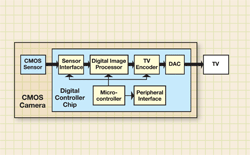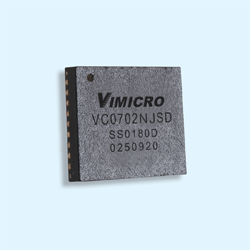Evaluating controller ICs for CMOS-sensor-cameras
The designer should understand the key issues, functions, and benefits before choosing a part
BY MIKE YU and SIMON QIU
Vimicro
Beijing, China
http://vimicro.com
The growing worldwide demand for security and public protection has spurred deployment of surveillance camera systems in security applications. To meet these needs, new generations of cameras, based on highly integrated digital image processor/controller chips, are paving the way for CMOS-sensor-based surveillance camera solutions to become the mainstream product in this market. The integrated controller/processor chips let designers add digital processing, connectivity, intelligence, along with low cost and low power consumption, thus causing fundamental changes in the surveillance camera market.

Fig. 1. A typical new generation CMOS-sensor-based surveillance camera system converts the sensor data into digital form and incorporates digital image processing to extract key information.
When selecting a solution for the next-generation surveillance camera, the digital controller chip and its feature set is the key to delivering the desired performance and flexibility. The next few paragraphs examine some of the key issues, functions and benefits that should be evaluated before selecting the controller for your next-generation CMOS-sensor-based surveillance system.
As illustrated in Fig. 1 , the latest CMOS-sensor based surveillance camera is basically a two-chip solution with a standard CMOS sensor and a digital controller chip that integrates a variety of digital image-processing functions, including a CMOS sensor interface, a digital image processor, a microcontroller, a TV encoder, and some peripheral digital interfaces. This digitally enhanced system architecture is essential to meet the ever-growing demand of more digital functions in surveillance cameras. For now, the dual-chip approach makes the most economic sense—cointegrating many digital functions and associated memory with the CMOS sensor imager is not economically feasible due to differences in yield rate and CMOS process technologies.
High-quality CMOS image sensors can deliver a spectrum of technical advantages, including low noise, large dynamic range, fast frame rate, and small form factor; while latest developments in digital image processing allow systems to enhance image quality and add more intelligence to the surveillance camera system. Those improvements impact both consumer and commercial security applications, creating new product opportunities and stimulating existing markets.
CMOS image sensors require special CMOS processes and are typically implemented using 180- or 250-nm design rules since the pixels must maintain a reasonable area to achieve sufficient sensitivity. Such circuits tend to have a yield rate below 80%. However, digital circuits can leverage the latest 130- or even 90-nm process technologies and can achieve yield rates well above 90%.
Thus, the dual-chip system partition approach will deliver the best performance/cost ratio for the new-generation CMOS-sensor-based surveillance camera system. This system-partitioning approach also gives the system designer a lot of flexibility, allowing the digital controller chip to link with the latest CMOS sensors of different resolutions (CIF, VGA, 1.3 Mpixel, etc.) and different output data formats (Bayer or YUV). System designers can thus develop surveillance cameras with rich and varying levels of features for the segmented and rapidly evolving consumer and commercial markets.
Digital image processing
The digital image processor lies at the core of the digital controller chip, offering many features that can be found in state-of-the-art digital camera products—image adjustment, digital zoom, auto-focus, and so forth. Some of the latest digital controller chips even contain interframe noise reduction schemes that have previously only been applied in complex digital TV chips. Such noise reduction schemes can deliver crisp video images even under low light conditions (approaching 0.1 lux).
Adaptive frame rate control
Most of the CMOS sensors in the market can only output progressive VGA-sized video up to 30 frames per second (fps), while TV format displays employ interlaced video at 50 fps for PAL and 60 fps for NTSC. To resolve the frame rate miss-match, an adaptive frame rate control block should be embedded in the controller chip together with an on-chip frame buffer (SRAM) to provide smooth video streaming.
However, a large frame buffer will, in general, substantially increase chip area and lower the chip-manufacturing yield and should therefore be avoided unless absolutely necessary. Commonly used image compression techniques such as JPEG and ADPCM may be further used to reduce the size of the frame buffer.
Digital storage
It is often critical to record a video clip locally when events take place. In the past, surveillance camera systems had relied on analog video tape recorders to do the job, which inevitably increased overall system cost and physical size. Since the video was recorded in analog TV format, it was also quite a hassle to transfer the video to a PC for further analysis (typically requiring an add-on PCI video capture card and driver software).
In the new CMOS-sensor systems, the digital controller chip typically incorporates an interface to common digital storage mediums such as NAND Flash, CF card, SD card, etc. Such cards are very compact in size and low in cost. If a powerful compression engine is integrated as part of the digital controller chip, the storage requirements for the digital media can be further reduced. The captured video clip can be sent to a TV for playback, or it can be easily transferred to a PC host for analysis or backup through widely available digital media card readers.
Connectivity
Wireless data services are quickly being deployed by service providers worldwide. With this infrastructure in place, and by integrating a wireless module (such as GPRS) into the digital surveillance cameras, wireless surveillance services can be implemented. Such an approach would allow the camera to send video clip/images to any mobile device in real time when events take place, or provide “store-and-forward” operations for less critical applications since the video is recorded and stored in standard digital compressed format and then transmitted on a preset schedule or on demand.
Intelligence
A key differentiation area for the new-generation CMOS-sensor cameras from previous-generation devices is the embedded digital intelligence that can be delivered to end users. For example, in many surveillance applications, motion detection and tracking are the key concerns. Therefore, accurate motion detection is a very valuable feature.
When motion is detected in the scene being monitored, an alert signal can be sent, and the video recording engine can be turned on. The motion detection is done by the embedded microcontroller and the digital image processor within the digital controller chip, rather than external motion detection units that are typically required by previous generation of surveillance cameras.
In another example, the digital controller chip could include a special block to detect backlight conditions (i.e., people in front of a light source) and add the right amount of exposure compensation automatically to produce a clear view of the scene. In previous generation systems, a switch was typically used to manually turn on/off a fixed level of backlight compensation, which was both inconvenient and error-prone (over-exposure or under-exposure).
With the help of the latest advances in CMOS process technology (i.e. 65 nm processes now ready for mass production at leading foundries) and more powerful image processing engines, more and more advanced features such as face detection, traffic pattern detection, and motion tracking may be integrated into the digital controller chip without driving up overall system cost and power consumption (see Fig. 2).

Fig. 2. The latest advances in CMOS process technology allow many features to be integrated into the digital controller.
Advertisement
Learn more about Vimicro USA





